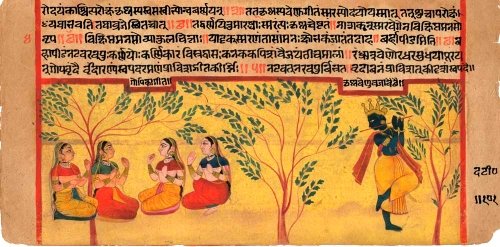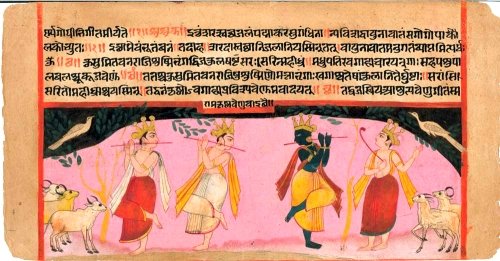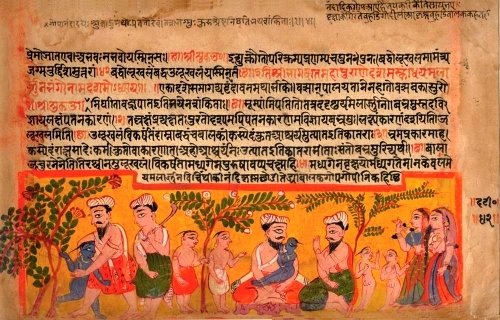
The Dancing
Krishna
- Harsha V Dehejia, Canada
e-mail: harshadehejia@hotmail.com
Images courtesy: Harsha V Dehejia
September 26, 2009
When we think of the artistic representation
of the dancing Krishna it is the rasa lila that comes to mind. The rasa
indeed is the central and concluding activity of the rasa panchadhyayi
of the dashama skandha of the Bhagavata Purana. The nightly rasa lilas
and the maha rasa on the purnima of sharada is pivotal to the understanding
of the shringara rasa of Krishna and artists delight in presenting this.
However the dancing form of Krishna is encountered in other situations
as well and must be considered for its aesthetic significance for a fuller
celebration of Krishna.
Dance is integral to all Hindu artistic
forms, both divine and sacred, and it would not be wrong to say that the
dancing human body is perhaps the most beautiful representation of the
human condition and the Indian world view. Through the dancing human form,
we are able to transcend the limitations of the form and create a feeling.
If the form is the vyakta, or the spoken, the feeling in that form is the
avyakta or the unspoken emotion. Shilpis and chitrakars alike delight in
creating dancing forms of our gods and goddesses. These forms arise from
a bedrock of sahitya or literature, which in the case of Krishna starts
with the Bhagavata and then proceeds through centuries of Krishna lore.
The various artistic forms of Krishna, whether in painting or sculpture,
are a form of visual poetry. In painting, the poetry is very often inscribed
on the front or the back of the painting, but even if it is not, the words
of the poet always resonate in the mind of the prepared Krishna aesthete
who is well versed in the rich and extensive literature of Krishna.

Movement in those artistic forms, through
the deflections of the body or bhangas, imparts not only grace but adds
a degree of sensuality that the static human figure cannot have. Through
movement the body transcends its limitations for the human spirit cannot
be bound and restricted by the constraints of time and space. Even more
the human body, through the gestures of the hands, movements of the eyes
and emotions on the face can express a thousand feelings even without a
single word. There is in the beauty of the dancing body not only motion
but a certain meaning, not just action but a pulsating emotion, and not
mere the ability to negotiate the commerce of life but to rise above the
banal and the pedantic and express the celestial and the transcendent.
It is the movement of the body that connects the otherwise sthula or static
body with ripples of thought in the mind, and when the movement of the
artistically created is one of dance, the human body becomes a vehicle
for the expression not just of arid thoughts but the lyrics and melody
of a song.

Through the karanas, or position of
the feet, the artistic creation of the dancing human figure becomes alive
with rhythm, and thus it is that the dancing body can resonate with the
rhythms of the universe around it. And it is through the combination of
movement and rhythm that an artist can bring to life the prana that is
the energy within the body. And when to the artistic creation of the human
body we give a musical instrument, like the flute in the case of Krishna,
the image then speaks to us not just in words but in lyrics, and we who
partake of that piece of art begin to dance with it. It is dance that most
beautifully expresses the rasa that indwells the human body, rasa understood
not only as the living sap that animates the body but the aesthetic sentiment
that is the life of the mind.
Krishna’s in the Bhagavata is marked
by his lilas and kridas, where he is a cowherd, sporting, dallying and
dances his way through Vrindavana. Notice how the Bhagavata records his
presence in Vrindavana:
Some gopas ran with the shadows
of flying birds
some walked gracefully like
royal swans
some sat down with cranes while
others danced with peacocks. X.12.8
Sometimes Krishna imitated the
rapturous notes of the swans
at other times he danced mimicking
dancing peacocks causing his companions to laugh. X.15.11
With their bodies decorated
with tender foliage, peacock feathers
clusters of flowers and coloured
earth
Balarama and Krishna along
with the gopas indulged in dancing, wresting and singing. X.18.9
Possessed of a charming personality
like an accomplished actor
graced by a crown of peacock
feathers
his ears decorated by
karnikara flowers
clad in garments yellow like
molten gold
wearing the Vaijayanti garland
made of five different colours
filling the holes of his flute
with the nectar of his lips
accompanied by the gopis singing
his glory
Krishna entered Vrindavana and
beautified it with his foot prints. X.21.5
Picturesquely clad in garments
intertwined with tender mango leaves
with tufts of peacock
feathers and bunches of flowers
and wearing garlands of lilies
and lotuses
and singing and dancing freely
in the midst of groups of gopas
they (Krishna and Balarama)
appeared very beautiful like actors on the stage. X.21.8 |
This sportive, playful presence of
Krishna merits depicting him in the dancing mode. How else could an artist
capture this persona of Krishna in Vrindavana?
 The earliest depictions of Krishna in
painting were in the illustrations of the Bhagavata and Gita Govinda done
in the 16th and 17th century in Gujarat. Deriving its motifs from the Jain
style, the figures of the Gujarat paintings set Krishna in Vrindavana and
did not show him as nayaka or a courtly person, just sitting or standing
regally, but invariably dancing with the gopis in the sylvan surroundings.
The ethos of the early Gujarat Bhagavata was simple but charming, the figures
thin and wiry, the expressions rustic and earthy, but there was in these
creations a joyous abandon of Krishna and the gopis. What it lacked in
sophistication it more than made up in sincerity. While not pretending
to be elegant, the dancing Krishna in the Gujarat paintings exudes a certain
down to earth truthfulness of shringara rasa. Similar dancing figures are
seen also in the early Gujarat Gita Govinda.
The earliest depictions of Krishna in
painting were in the illustrations of the Bhagavata and Gita Govinda done
in the 16th and 17th century in Gujarat. Deriving its motifs from the Jain
style, the figures of the Gujarat paintings set Krishna in Vrindavana and
did not show him as nayaka or a courtly person, just sitting or standing
regally, but invariably dancing with the gopis in the sylvan surroundings.
The ethos of the early Gujarat Bhagavata was simple but charming, the figures
thin and wiry, the expressions rustic and earthy, but there was in these
creations a joyous abandon of Krishna and the gopis. What it lacked in
sophistication it more than made up in sincerity. While not pretending
to be elegant, the dancing Krishna in the Gujarat paintings exudes a certain
down to earth truthfulness of shringara rasa. Similar dancing figures are
seen also in the early Gujarat Gita Govinda.
These dancing images of Krishna are
in contrast to the courtly Krishna of the 18th and 19th centuries, where
he is sedate and stately, moving regally in opulent surroundings and in
a romantic association with Radha and not gopis. The early Gujarat dancing
Krishna has the innocence of the cowherd Krishna dallying in the luxuriant
Vrindavana and true to Vallabhacharya’s Madhurashtakam, he was truly akhilam
madhuram, all together sweet and mellifluous.

Harsha V Dehejia has a double
doctorate, one in medicine and the other in Ancient Indian Culture, both
from Mumbai University. He is a practicing Physician and an Adjunct Professor
of the Division of Religion in the College of Humanities at Carleton University
in Ottawa, ON., Canada. His special interest is in Indian Aesthetics. He
has 12 books to his credit. He writes mostly on Krishna.
|







